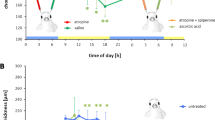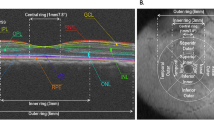Abstract
In chicks, axial length and choroidal thickness undergo circadian oscillations. The choroid is innervated by both branches of the autonomic nervous system, but their contribution(s) to these rhythms is unknown. We used two combination lesions to test this. For parasympathectomy, nerve VII was sectioned presynaptic to the pterygopalatine ganglia, and the ciliary post-ganglionics were cut (double lesion; n = 8). Triple lesions excised the sympathetic superior cervical ganglion as well (n = 8). Sham surgery was done in controls (n = 7). 8–14 days later, axial dimensions were measured with ultrasonography at 4-h intervals over 24 h. Rhythm parameters were assessed using a “best fit” function, and growth rates measured. Both types of lesions resulted in ultradian (> 1 cycle/24 h) rhythms in choroidal thickness and axial length, and increased vitreous chamber growth (Exp-fellow: double: 69 µm; triple: 104 µm; p < 0.05). For double lesions, the frequency was 1.5 cycles/day for both rhythms; for triples the choroidal rhythm was 1.5 cycles/day, and the axial was 3 cycles/day. For double lesions, the amplitudes of both rhythms were larger than those of sham surgery controls (axial: 107 vs 54 µm; choroid: 124 vs 29 µm, p < 0.05). These findings provide evidence for the involvement of abnormal ocular rhythms in the growth stimulation underlying myopia development.







Similar content being viewed by others
Notes
We do not know how long the cell bodies in the pterygopalatine ganglia remain intact following the pre-synaptic lesion, but it is generally accepted that a pre-synaptic lesion will substantially reduce transmission via the post-synaptic pathway.
Abbreviations
- ARVO:
-
Association for Research in Vision and Ophthalmology
- CG:
-
Ciliary ganglion
- CGX:
-
Ciliary ganglion lesion
- N VII:
-
Cranial nerve VII
- PPG:
-
Pterygopalatine ganglia
- PPGX:
-
Pterygopalatine ganglion pre-synaptic (NVII) lesion
- RPE:
-
Retinal pigment epithelium
References
Blessing W, Ootsuka Y (2016) Timing of activities of daily life is jaggy: how episodic ultradian changes in body and brain temperature are integrated into this process. Temperature 3:371–383
Bourguignon C, Storch KF (2017) Control of rest: activity by a dopaminergic ultradian oscillator and the circadian clock. Front Neurol 8:614
Buijs RM, Fleur SE, Wortel J, van Heyningen C, Zuiddam L, Mettenleiter TC, Kalsbeek A, Nagai K, Niijima A (2003) The suprachiasmatic nucleus balances sympathetic and parasympathetic output to peripheral organs through separate preautonomic neurons. J Comp Neurol 464:36–48
Chakraborty R, Ostrin L, Nickla D, Iuvone P, Pardue M, Stone RA (2018) Circadian rhythms, refractive development, and myopia. Ophthalmic Physiol Opt 38:217–245
De Stefano M, Mugnaini E (1997) Fine structure of the choroidal coat of the avian eye: lymphatic vessels. Investig Ophthalmol Vis Sci 38:1241–1260
Lauber JK, Boyd JE, Boyd TAS (1972) Sympathetic denervation effects of avian eye development and aqueous fluid dynamics. Proc Soc Exp Biol Med 140:351–356
Lin T, Zhu X, Capehart C, Stone RA (1996) The ciliary ganglion and vitreous cavity shape. Curr Eye Res 15:453–460
Marzani D, Wallman J (1997) Growth of the two layers of the chick sclera is modulated reciprocally by visual conditions. Investig Ophthalmol Vis Sci 38:1726–1739
McDougal DH, Gamlin PD (2015) Autonomic control of the eye. Compr Physiol 5:439–473
Meriney S, Pilar G (1987) Cholinergic innervation of the smooth muscle cells in the choroid coat of the chick eye and its development. J Neurosci 7:3827–3839
Nickla D (2005) The phase relationships between the diurnal rhythm in axial length and choroidal thickness and the association with ocular growth rate in chicks. J Comp Physiol A 192:399–407
Nickla DL, Schroedl F (2012a) The effects of double parasympathectomy on the diurnal rhythms in choroidal thickness and axial length in chicks. ARVO E-Abstract #3433
Nickla DL, Schroedl F (2012b) Parasympathetic influences on emmetropization in chicks: evidence for different mechanisms in form deprivation vs negative lens-induced myopia. Exp Eye Res 102:93–103
Nickla DL, Wallman J (2010) The multifunctional choroid. Prog Retin Eye Res 29:144–168
Nickla DL, Wildsoet C, Wallman J (1998) Visual influences on diurnal rhythms in ocular length and choroidal thickness in chick eyes. Exp Eye Res 66:163–181
Nickla DL, Rada JA, Wallman J (1999) Isolated chick sclera shows a circadian rhythm in proteoglycan synthesis perhaps associated with the rhythm in ocular elongation. J Comp Physiol [A] 185:81–90
Ohngemach S, Feldkaemper MP, Schaeffel F (2001) Pineal control of the dopamine D2-receptor gene and dopamine release in the retina of the chicken and their possible relation to growth rhythms of the eye. J Pineal Res 31:145–154
Papastergiou GI, Schmid G, Riva CE, Mendel MJ, Stone RA, Laties AM (1998) Ocular axial length and choroidal thickness in newly hatched chicks and one-year-old chickens fluctuate in a diurnal pattern that is influenced by visual experience and intraocular pressure changes. Exp Eye Res 66:195–205
Rada JA, Thoft RA, Hassell JR (1990) Extracellular matrix changes in the sclera of chickens with experimental myopia. Investig Ophthal (ARVO Suppl) 31:253
Rada JA, Thoft RA, Hassell JR (1991) Increased aggrecan (cartilage proteoglycan) production in the sclera of myopic chicks. Dev Biol 147:303–312
Rada JA, McFarland AL, Cornuet PK, Hassell JR (1992) Proteoglycan synthesis by scleral chondrocytes is modulated by a vision dependent mechanism. Curr Eye Res 11:767–782
Reiner A, Karten HJ, Gamlin PDR, Erichsen J (1983) Functional subdivisions and circuitry of the avian nucleus of Edinger–Westphal. TINS 6:140–145
Rucker F, Troilo D, Zhu X, Bitzer M, Schaeffel F, Wallman J (2009) Interocular lens interactions in lens compensation: yoking and anti-yoking. Investig Ophthalmol Vis Sci 50:3931
Schmid K, Wildsoet CF (1996) Effects of the compensatory responses to positive and negative lenses of intermittent lens wear and ciliary nerve section in chicks. Vis Res 36:1023–1036
Schmid GF, Papastergiou GI, Lin T, Riva CE, Laties AM, Stone RA (1999) Autonomic denervations influence ocular dimensions and intraocular pressure in chicks. Exp Eye Res 68:573–581
Schroedl F, Tines R, Brehmer A, Neuhuber W (2001) Intrinsic choroidal neurons in the duck eye receive sympathetic input: anatomical evidence for adrenergic modulation of nitrergic functions in the choroid. Cell Tissue Res 304:175–184
Smith EL, Hung LF, Kee CS, Qiao Y (2002) Effects of brief periods of unrestricted vision on the development of form deprivation myopia in monkeys. Investig Ophthalmol Vis Sci 43:291–299
Stone RA, Wei W, Sarfare S, Pan W, Engelhart KC, Khurana T, McGuire MG, Iuvone PM, Nickla D (2018) Diurnal cycling of clock and melanopsin genes in chick choroid. ARVO E-Abstract #5048
Stubinger K, Brehmer A, Neuhuber WL, Reitsamer H, Nickla DL, Schroedl F (2010) Intrinsic choroidal neurons in the chicken eye: chemical coding and synaptic input. Histochem Cell Biol 134:145–157
Vujovic N, Davidson AJ, Menaker M (2008) Sympathetic input modulates, but does not determine, phase of peripheral circadian oscillators. Am J Physiol Regul Integr Comp Physiol 295:355–360
Wallman J, Winawer J (2004) Homeostasis of eye growth and the question of myopia. Neuron 43:447–468
Wallman J, Wildsoet C, Xu A, Gottlieb M, Nickla D, Marran L, Krebs W, Christensen A (1995) Moving the retina: choroidal modulation of refractive state. Vis Res 35:37–50
Weiss S, Schaeffel F (1993) Diurnal growth rhythms in the chicken eye: relation to myopia development and retinal dopamine levels. J Comp Physiol A 172:263–270
Wildsoet C, Wallman J (1995) Choroidal and scleral mechanisms of compensation for spectacle lenses in chicks. Vis Res 35:1175–1194
Acknowledgements
This work was funded by the National Eye Institute NIH-NEI-013636 and NIH-NEI-025307. The authors thank Kristen Totonelly and Jonathan Elin-Calcador for collecting some of the data. Care and use of animals conformed to the ARVO Resolution for the Care and Use of Animals in Research.
Author information
Authors and Affiliations
Corresponding author
Additional information
Publisher’s Note
Springer Nature remains neutral with regard to jurisdictional claims in published maps and institutional affiliations.
Rights and permissions
About this article
Cite this article
Nickla, D.L., Schroedl, F. Effects of autonomic denervations on the rhythms in axial length and choroidal thickness in chicks. J Comp Physiol A 205, 139–149 (2019). https://doi.org/10.1007/s00359-018-01310-4
Received:
Revised:
Accepted:
Published:
Issue Date:
DOI: https://doi.org/10.1007/s00359-018-01310-4




